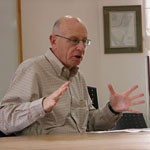By Ira Sharkansky, Ph.D

JERUSALEM — You want it, you pay for it. Economic liberalism is the essence of the American experience. Don’t tread on me. Don’t make me pay for someone else’s benefit.
Of course it’s not total. In the U.S., there are programs to pay, or help to pay for those in need. And there’s lots of insurance, often associated with a job, that pays most or all of health care needs. And government programs to lend money for education.
But the costs of higher education? Outlays for private colleges and universities reach $85,000 a year, including living expenses. At state universities it could be $55,000 for those not residents of the state, or more than $30,000 per year for those who are residents. At private colleges, some $65,000 of the total is for tuition and fees. At a public university tuition ranges upward of $10,000 for residents and $40,000 for non-residents of the state..
You can borrow to pay. Then it becomes another mortgage, to be paid in installments throughout one’s working life. Data show that the debt is substantial, with many cases of deferred payment, falling behind, and defaults or not paying. Burdens are especially great for those who attended for-profit colleges, whose training has not prepared them for jobs earning enough to both pay the debt, and provide for life.
Parents begin saving for their kid’s college when the kids are young. Some begin programs at birth. And some parents borrow.
Medical costs, at $300 to $600 per visit to a physician without insurance. And hospital costs over #10,000 per day.
University tuition in Israel is a bit more than NIS 10,000 (equivalent to $3,100) per year. In many European countries, there is no tuition for national residents.
There are many who think that populations of the US and elsewhere are over-educated. That is, they’ve taken courses unnecessary for earning a living. There are plenty of on-line, and specialized courses tailored for entering high-tech. College enrollments in the humanities i.e., art, literature, religion, music, history, philosophy, are declining. Society is preparing a cluster of nerds who may prosper, but haven’t been exposed to thinking or enjoying what’s beyond spectator sports, and a weekend at the beach..
And who pays for medical care in most developed countries outside of the US? The government, via taxes.
If you have a problem with US taxes. And you live overseas. No toll-free number to call. You’ll wait a long time on the line for a representative. And to write your query? That may take months to be answered.
Is this the American dream? There are more than enough who want in, especially from poorer countries to the south or the east. And others who aspire to the freedom and opportunities of America. There’s plenty of space, and work opportunities ranging from cleaners up to high-tech.
Guesses are that three times the number of Western Europeans move to the United States as Americans move to Western Europe. And lots more coming to America from Eastern Europe, Africa and Asia.
Among the attractions of the US, especially for Israelis who are looking elsewhere, there is no compulsory military service in the US. The country remains active elsewhere, but there are enough volunteers to fill the ranks. Within the US, service is highly correlated with family. Many are the children of those who have served. Pay, benefits, retirement, are among the attractions. Enlistments are especially high in the South, and close to military bases.
Those looking for a good life can choose between a crowded, but lively city, a small village, or the wide open spaces with little traffic.
The state that you choose is important. The country is the United States. Foreigners tend to view it as a whole, and focus on what the national government does overseas. Yet the states provide the bulk of what residents receive, and–along with their local governments–a substantial part of what they pay by way of taxes and other charges. Those payments come in a variety of ways: income taxes, property taxes, school levies, water and sewage payments, and other add-ons peculiar to individual states or localities. Americans identify with their states. Most don’t move from one state to another. One study shows that 72 percent of Americans continue to live near where they grew up. Language, by way of accents, varies from place to place. And at least a bit of pride in what one’s state or locality stands for in memories going back to grammar school.
Especially since the New Deal of Franklin Delano Roosevelt, the national government has provided substantial grants of money to states and localities, in exchange for compliance with national standards of service. And, since the 1960s, the issue of racial segregation has left, at least formally, what the state and local governments can impose on their populations. All can vote, and all can wage their campaigns against politicians who fudge district boundaries, seek to curtail voting by mail, or impose other tricks to shape the outcome of elections.
National standards remain, but are somewhat elusive. Some are vague guidelines, left to state and local officials and activists to interpret and act upon, or act against. To a considerable extent, it leaves a lot to individual decision and initiative. And the US has the highest scores, among developed countries, for gaps between those who have more and those who have less.
For those with resources, and a desire for independence, it’s a great place.
*
Ira Sharkansky, PhD, is professor emeritus of political science at Hebrew University. He may be contacted via ira.sharkansky@sdjewishworld.com